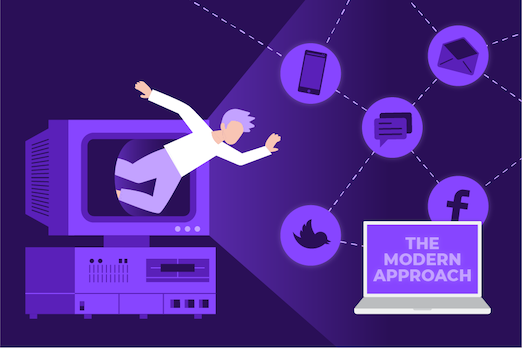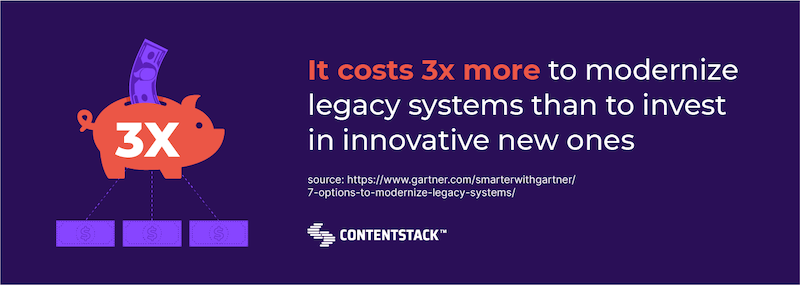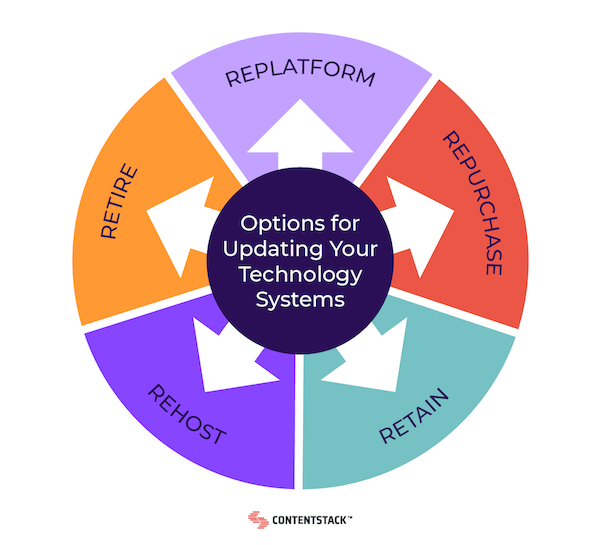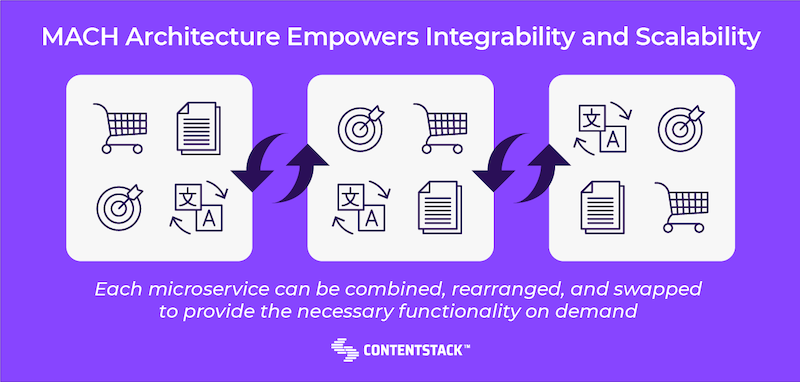Leaning Away from Legacy Tools: Modernize Your Tech Stack with MACH

Inertia is a tough force to overcome, especially when it comes to upgrading your technology stack. Even if your team is struggling under the weight of clunky and outdated tools, deciding how to get unstuck can quickly lead to analysis paralysis as you try to figure out how to modernize your tools without creating chaos.
If this sounds familiar, you’re in good company. A report by Infosys found that legacy systems are one of the biggest barriers to digital transformation — alongside aversion to risk. This powerful pairing can make transformation even more challenging. In this post, we help technology leaders diagnose the obstacles of legacy tech and provide a recommendation for the infrastructure upon which to build a lean, modern, and future-proof tech stack.
Why Leaving a Legacy Isn’t Always Good
In the technology business, legacy is a loaded word. It can reflect an expensive capital investment that took years of careful financial planning, or it can represent a barrier to adopting a modern and efficient way of doing business. Or it can be both.
Legacy systems may have been cutting-edge in their heyday, when technical tasks were centralized and computers belonged on desks, but today they have become expensive and difficult to maintain. And they don’t integrate well — if at all — with modern tools. They are, however, still frustratingly difficult to lean away from because organizations have built whole business processes and cultures around them, and changing those can feel like trying to turn the Titanic.
While the term legacy is often associated with last generation or end-of-life components, a tool or process doesn’t need to be that old to be considered legacy. If any of these apply to your organization, it’s time to think about how to lean away from the legacy:
- You rely on technology that has become unstable and hard to repair since support has been discontinued or hardware components are no longer available. Lack of support makes data reporting unreliable and cumbersome, especially if your data is stored on physical servers instead of in the cloud, leaving you vulnerable to data loss.
- You use tools that won’t integrate with modern solutions and it’s keeping you from reaching your business goals. Lack of integration and scalability means that your growth plans get stalled or you have to layer on additional piecemeal solutions to fill the gaps, which creates more data silos and negatively impacts data analytics.
- You run proprietary systems that are hard to learn, making it increasingly challenging to retain internal expertise to maintain them. You might spend more time managing tools than contributing to business outcomes.
At best, legacy tools are ones that can’t help you move forward. At worst, they threaten your organization’s growth and security. The good news is that you don’t need to stay stuck.
How to Lean Away From Legacy Tools
The best strategy for making smart decisions about legacy systems is to focus on your current needs, not on the tools you adopted to meet your past needs. While it’s hard to forget how expensive and ingrained some of your tech systems might be, that train of thought goes backward, not forward. Your business has evolved and the pace of digital innovation has skyrocketed since those early investments. It’s only natural that your technology stack needs an upgrade.

All you need is the right strategy to refresh your legacy tools and get out ahead of the competition.
1. Articulate Your Business Goals
As digital tools have transformed the business landscape, your company’s strategies have no doubt changed since you first bought into your existing tech stack. For example, the shift to online shopping has altered priorities for retailers that started as brick-and-mortar storefronts, and the anything-as-a-service model has created whole new business lines across sectors, from FinTech to publishing.
Take the time to understand what your company’s business goals are today, as well as where your company expects to grow in the next three to five years. In parallel, take stock of the tools that will drive that growth. What do you have? What does your organization need? Resist the urge to align your needs with specific products. Instead, name the function you need to perform.
2. Set Your Business Priorities
To get the most from your tech budget, choose a small number of priorities that will help you address your biggest pain points and drive your business forward. Whether you need to tear down data silos or completely update your ecommerce strategy, identify the areas that would benefit the most from a tech refresh — both today and in the future.
As you do this, be sure to engage stakeholders and leadership throughout your organization. Change is hard for everyone, but you’re less likely to face resistance if your decisions take everyone’s needs into consideration.
3. Assess Your Technology Options
Leaning away from some old tools gives you the chance to lean toward some new ones. It’s unrealistic that you’ll be able to overhaul everything at once, so instead go in planning to rework your technology using a spectrum of options, including:
- Retain what you have
- Retire old tools you can live without
- Rehost your apps and services in the cloud
- Repurchase new tools to perform existing functions
- Replatform your system with new cloud-based tools

Chances are high that your various systems and solutions will require several of the above actions. It’s important to remember when evaluating your legacy tools that technology as a whole is moving away from monolithic enterprise systems where applications are dependent on the underlying infrastructure and toward more nimble options that were designed to meet today’s fast-evolving environment.
What to Lean Toward: MACH Technology
The MACH approach to tech architecture is fast becoming the preferred course by modern organizations who want to future-proof their tech investments. MACH technology solutions are Microservices-based, API-first, Cloud-native, and Headless. But it’s not as complex as it sounds. To put it simply, the MACH approach provides agility, scalability, and efficiency through ease of integration.

Here’s how each feature of MACH technology can help you eliminate and consolidate the disparate tools that are currently holding you back:
Microservices Optimize Functionality With Best-of-Breed Solutions
Microservices are individual pieces of business functionality that are designed to expertly perform one specific task. Because they’re small and focused, they can be deployed and updated quickly. Choosing microservices allows you to select the best-of-breed tools to meet your needs instead of having to settle for what’s available in an enterprise suite.
API-First Means Seamless Integrations
Using an application programming interface (API) allows data to flow between multiple applications or services, helping you eliminate data silos and level up your data analytics. Well-designed APIs increase your flexibility, simplify development, and accelerate your time-to-market.
Cloud-Native Systems Deliver Scalability at Speed
When your apps and tools are developed and delivered in the cloud, you have built-in scalability that boosts performance when you need it.
Headless Architecture Accelerates Omnichannel Delivery
Headless architecture separates front-end presentation and back-end logic. This enables you to use APIs to bring together your microservices of choice without disrupting the flow of business.
For example, a headless content management system (CMS) allows you to connect your content repository on the backend to a wide variety of front-end channels; such as websites, mobile apps, or Internet of Things devices. And it does this while giving designers and developers the freedom to shape the front-end without the constraints of rigid templates. In today’s marketplace, where end-user expectations are constantly changing, going headless is a critical part of business success.

To learn more about how your tech team can spend less time patching your legacy content systems and more time building things that matter, dive into the details of Contentstack — a MACH-enabled headless CMS.
And to learn more about MACH tools and how they can help you future-proof your tech stack, download a free copy of our eBook: Break the Replatform Cycle with MACH Enterprise Architecture and hear from digital leaders and their lessons on how to align company culture, evaluate solutions, and gain momentum with early technology wins.About Contentstack
The Contentstack team comprises highly skilled professionals specializing in product marketing, customer acquisition and retention, and digital marketing strategy. With extensive experience holding senior positions at renowned technology companies across Fortune 500, mid-size, and start-up sectors, our team offers impactful solutions based on diverse backgrounds and extensive industry knowledge.
Contentstack is on a mission to deliver the world’s best digital experiences through a fusion of cutting-edge content management, customer data, personalization, and AI technology. Iconic brands, such as AirFrance KLM, ASICS, Burberry, Mattel, Mitsubishi, and Walmart, depend on the platform to rise above the noise in today's crowded digital markets and gain their competitive edge.
In January 2025, Contentstack proudly secured its first-ever position as a Visionary in the 2025 Gartner® Magic Quadrant™ for Digital Experience Platforms (DXP). Further solidifying its prominent standing, Contentstack was recognized as a Leader in the Forrester Research, Inc. March 2025 report, “The Forrester Wave™: Content Management Systems (CMS), Q1 2025.” Contentstack was the only pure headless provider named as a Leader in the report, which evaluated 13 top CMS providers on 19 criteria for current offering and strategy.
Follow Contentstack on LinkedIn.







.svg?format=pjpg&auto=webp)
.svg?format=pjpg&auto=webp)
.png?format=pjpg&auto=webp)






.png?format=pjpg&auto=webp)


